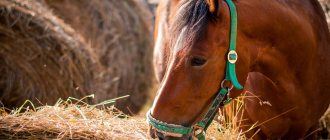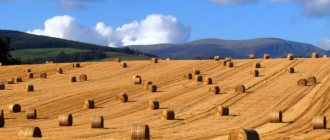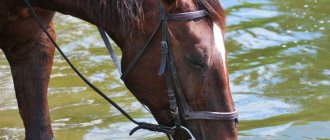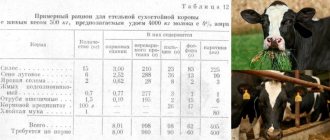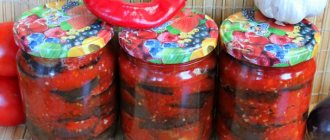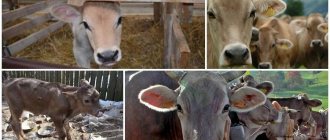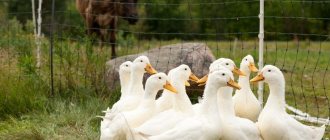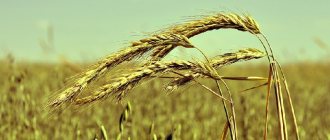Haylage
Haylage is food prepared from grasses dried to 50-55% moisture. The preservative factor of haylage is the physiological dryness of the mass and anaerobic storage conditions. When the humidity of the mass is 50-55%, most bacteria sharply reduce their vital activity.
Only for molds these conditions are not an obstacle to active development (their vital activity ceases under anaerobic conditions). The activity of lactic acid bacteria in this environment is significantly reduced, so less organic acids are formed in the haylage and more sugar remains.
The acidity of haylage (pH), depending on the type of grass, is 4.5-5.5, it is characterized by high nutritional value (0.35-0.42 feed units, 38-65 g of digestible protein per 1 kg), good palatability and digestibility of nutrients .
When preparing haylage, preference should be given to legumes and leguminous-cereal grasses - alfalfa, clover, sainfoin - and their mixtures with cereal grasses. Legumes contain 1.5-2 times more digestible protein and carotene.
Good quality haylage can be prepared from perennial cereal grass mixtures and annual legume-cereal mixtures. Therefore, it is advisable for farms to create a specific hay conveyor. This will make it possible to harvest haylage throughout the growing season, obtain more nutritious feed, and rationally use equipment and labor.
Grasses for haylage should be mowed in earlier phases of development, legumes - during the budding period, cereals - at the beginning of heading; Finish harvesting at the beginning of flowering. This is critical in obtaining highly nutritious feed.
The area of grass mowed per day for haylage should not exceed the possibility of mechanical harvesting after wilting. Otherwise, this causes a violation of technological requirements when preparing haylage, and the feed is of low quality and with large losses during procurement and storage.
All types of harvesting equipment are used for mowing grass, but the indispensable conditions are flattening legumes in good sunny weather and turning the mass in windrows. This ensures faster drying and maintains high quality feed. For mowing, roller mower-conditioners KPS-5G and E-301 are most often used. At the same time, it is important to ensure that in case of a high yield, for quick and uniform wilting, the mass of freshly cut plants in windrows does not exceed 4-5 kg per 1 m (running m). The width of the windrow should be 1.25-1.30 m and be as close as possible to the working width of the pick-up chopper.
Annual grasses (pea-vetch-oat mixture, Sudan grass, etc.) are mowed only in windrows, since when selecting wilted plants from the swaths, the mass becomes contaminated with soil. Annual grasses for haylage should be harvested in stable sunny weather.
It is very important to control the moisture content of the mass. The selection of rolls begins when the moisture content of the mass reaches 60-65%, in order to remove the main amount of it at optimal humidity (55-60%).
Monitoring changes in the moisture content of the mass should be carried out using a Chizhova moisture meter or visually using the following signs. At a humidity of 55-60%, the stems and leaves become soft, but do not break off or crumble; when the plants are strongly squeezed in the hand, no juice is released; after unclenching the hand, the crushed mass crumbles. When the humidity of the mass is 40-45%, the grass leaves break off and crumble.
The main requirement for the selection of mass is its good grinding. The mass with a cutting length of up to 30 mm must be at least 75%. The mass, dried to 50% humidity and finely crushed, easily swells when loaded into vehicles under the air pressure of the pick-up chopper. Therefore, to reduce loading losses, all vehicles must be equipped with removable shields.
Even with strong compaction, many pores remain in the haylage mass, through which air easily penetrates into the deep layers. In this case, the physical dryness of the environment does not delay the rapid development of undesirable microbiological processes. The main conditions for obtaining high-quality haylage from green feed are rapid filling of storage facilities and the creation of anaerobic conditions.
The peculiarity of laying haylage in a trench is that the dried mass must be continuously and thoroughly compacted. The thickness of the compacted layer of mass laid daily must be at least 1 m. To compact it, only crawler tractors of the S-100 type must be used. For every 100-120 tons of mass, one caterpillar tractor is allocated.
During the process of laying and compacting the mass, its temperature should not exceed 37°. If the temperature rises above the specified limit, then it is necessary to speed up the filling and increase the intensity of compaction.
When storing haylage in trenches, a large amount of spoiled feed occurs along the walls, on top and at the ends of the storage facility. Therefore, special attention should be paid to compacting the mass near the walls, leveling it, compacting it and forming a convex surface to ensure good drainage of rainwater.
Plant mass dried to a moisture content of 50% is difficult to compact. Therefore, upon completion of laying, a layer of freshly cut, finely chopped, easily silaged grass 20-30 cm thick should be placed on its surface. In this case, the green mass acts as a protective layer from the access of air and additional cargo. At the end of laying, the layer of feed should be 0.5 m above the level of the walls, along the center line - by 1.2-1.5 m.
The well-leveled and compacted surface of the mass is carefully covered with a canopy of polyethylene film and a layer of earth or peat about 10 cm thick.
Introduction
Traditional winter feeds for farms - hay and silage - are characterized by very low nutritional value, which forces livestock farmers to increase the share of concentrates in cattle diets in winter.
An alternative to these feeds is haylage. This is the only type of winter feed that maximally preserves metabolic energy, protein, sugar, carotene and at the same time is sufficiently concentrated (dry) to provide feeding for highly productive animals. Throughout the world, haylage production has been increasing over the past 30 years, and its share of bulk feed now accounts for more than half.
The fact is that if the technology for preparing haylage is followed and legumes are used during optimal growth phases, the concentration of metabolic energy and protein in the dry matter of the feed increases. The use of such high-quality haylage makes it possible to reduce the consumption of concentrates, which is inevitable with low-quality bulky feed. And in feeding dairy cattle, high-quality haylage can be used as the only bulk feed (3).
Haylage is traditionally a “difficult” feed, the harvesting of which farms deliberately avoid, because here it is necessary to very carefully and scrupulously follow the technology. Losses in quantity and quality occur at almost all stages: in the field when the drying process is delayed; in case of insufficient compaction of haylage in the trench; due to incomplete sealing; losses during extraction and distribution of feed. The total losses amount to more than 20-25% of the prepared feed (8).
Haymaking technology
The technology for preparing haylage includes the following operations:
■ mowing and wilting plants; ■ selecting grass from windrows, chopping it and loading it into vehicles; ■ transportation and storage; ■ covering storage facilities.
Grasses are cut with all types of mowers.
Grasses should be mowed in the morning, when the plants contain the greatest amount of carotene. Loss of other nutrients is also minimal.
To speed up and more uniform wilting of perennial legumes, flattening is carried out, which reduces the wilting time by 2-3 times. Mower-conditioners are used for this purpose.
In order to preserve carotene, it is advisable to rake the mass into windrows after several hours of drying and dry the plants in them. For this purpose, wheel-finger rakes are used.
You can also use a reaper to mow grass and dry the plant matter in a windrow.
To speed up wilting, you need to ted with a rake or tedder, repeating this procedure every 2-4 hours.
Place the herbs in storage at a humidity of 55-60%. Reducing the moisture content of the mass to 45% or less is undesirable.
To determine the readiness of the grass for selection, moisture content is determined. To do this, 2-3 days before mowing the grass, its dry matter content is determined: an average sample of grass weighing about 1 kg is packaged in a plastic bag and urgently delivered to the nearest laboratory, where analysis must be performed immediately.
Knowing the moisture content of plants while they are standing, one can approximately determine their moisture content during the wilting process. To do this, weigh 10 kg of freshly cut herbs and lay them out on the same field and in the same layer as the rest of the plants.
A control batch of grass is weighed periodically.
The moisture content of dried grass (W,%) is calculated using the formula W = 100 - 10X/m,
where X is the mass fraction of dry matter in standing plants, %; m is the mass of dried grass, kg. For example, the moisture content of standing alfalfa is 80%, i.e. its dry matter content is 20%. After drying the control batch (10 kg), its weight became 5 kg, therefore, the moisture content is:
100 — 10*20/5 = 100-40 = 60%.
To determine the moisture content of dried legume grass, you can use ready-made data (see Table 3.8). It is necessary to know the percentage of moisture in standing plants, then on the day of mowing, weigh out 10 kg of grass, spread it on the stubble and weigh it periodically. When the weight of the control batch reaches the value shown in the table, the moisture content of the dried grass will be 60%.
At this moisture level, the plants begin to be selected and chopped.
The moisture content of standing legumes can be determined by the condition of the plants. At a humidity of 55-60%, the leaves are flexible, the stem is limp, the upper part is still fresh. Cereals also have flexible, slightly flaccid leaves and an elastic stem; In young plants, the split stem is almost fresh inside.
At a humidity of 40-45% in legumes, most of the lower leaves are dry, curled, and the leaf petioles begin to break; If you pass the stem between your nails, moisture comes out.
In cereals, the leaves are dried out, rustle, flexible, but do not crumble, the stem is elastic. Determination of the moisture content in the dried mass can also be carried out using a Chizhova moisture meter (VChM), devices VZM-1M, VLK-0.1, etc.
The selection of the dried mass, its grinding and loading into vehicles is carried out by pick-up choppers. To obtain a more uniform cutting (3-5 cm), it is necessary to constantly monitor the sharpness of the knives and adjust the gap in the chopping apparatus.
Price list “Materials for feed procurement”
| Name | Unit change | Price, rub |
BLACK SILAGE FILMS (France, Finland) | ||
| Silage film black 120, 125, 150 microns, wide. 12 m, roll 50 m | roll | on request |
| Silage film black 120, 125, 150 microns, wide. 14 m, roll 50 m | roll | on request |
| Silage film black 120, 125, 150 microns, wide. 16 m, roll 50 m | roll | on request |
| Silage film black 120, 125, 150 microns, wide. 18 m, roll 50 m | roll | on request |
| Silage film black 120, 125, 150 microns, wide. 20 m, roll 50 m | roll | on request |
| Silage film black 120, 125, 150 microns, wide. 22 m, roll 50 m | roll | on request |
SILAGE FILMS BLACK AND WHITE (Finland) | ||
| Silage film black and white 120, 125, 150 microns, wide. 12 m, roll 50 m | roll | on request |
| Silage film black and white 120, 125, 150 microns, wide. 14 m, roll 50 m | roll | on request |
| Silage film black and white 120, 125, 150 microns, wide. 16 m, roll 50 m | roll | on request |
| Silage film black and white 120, 125, 150 microns, wide. 18 m, roll 50 m | roll | on request |
| Silage film black and white 120, 125, 150 microns, wide. 20 m, roll 50 m | roll | on request |
| Silage film black and white 120, 125, 150 microns, wide. 22 m, roll 50 m | roll | on request |
SILAGE FILM TRANSPARENT (France, Finland) | ||
| Transparent silage film 40 microns, wide. 12 m, roll 100 m | roll | on request |
| Transparent silage film 40 microns, wide. 14 m, roll 100 m | roll | on request |
| Transparent silage film 40 microns, wide. 16 m, roll 100 m | roll | on request |
| Transparent silage film 40 microns, wide. 18 m, roll 100 m | roll | on request |
| Transparent silage film 40 microns, wide. 20 m, roll 100 m | roll | on request |
| Transparent silage film 40 microns, wide. 22 m, roll 100 m | roll | on request |
HAY KNITING NETS (Israel, Finland) | ||
| Hay knitting mesh width 123cm, roll 3000m | roll | on request |
| Hay knitting mesh width 125cm, roll 3600m | roll | on request |
| Hay knitting mesh width 130cm, roll 3000m | roll | on request |
| Hay knitting mesh width 130cm, roll 4000m | roll | on request |
HAY KNITING TWINES | ||
| Hay tying twine 2200 tex – 454 m/kg | kg | on request |
| Hay tying twine (Serbia) – 500 m/kg | kg | on request |
| Hay tying twine (Israel) – 750 m/kg | kg | on request |
| Hay tying twine (Finland) – 130 m/kg | kg | on request |
AGROSTRECH FILM FOR HAILAGE (Sweden, Finland) | ||
| Agrostretch width 500mm, roll 1800m, 22 microns | roll | on request |
| Agrostretch width 750mm, roll 1500m, 22 microns | roll | on request |
| Agrostretch width 500mm, roll 1800m, 25µm | roll | on request |
| Agrostretch width 750mm, roll 1500m, 25µm | roll | on request |
POLYMER SLEEVES FOR GRAIN (Finland - Czech Republic) | ||
| Polymer sleeve 1.52x60m | PC | on request |
| Polymer sleeve 1.65x60m | PC | on request |
| Polymer sleeve 1.98x60m | PC | on request |
| Polymer sleeve 2.43x60m | PC | on request |
| Polymer sleeve 2.43x75m | PC | on request |
| Polymer sleeve 2.74x60m | PC | on request |
| Polymer sleeve 2.74x75m | PC | on request |
Harvesting haylage: mistakes in the practice of Belarusian farms
The finer and more uniform the cutting, the higher the quality of the haylage. This mass compacts well and prevents air penetration. To obtain high-quality haylage, the preparation of trenches and their filling are of great importance. New trenches should be located in elevated areas, preferably in clay soil.
The dimensions of the trench are selected depending on the proximity of groundwater and the availability of equipment on the farm (based on filling and covering the trench within 2-3 days). Recommended transverse dimensions of the trench: along the bottom - 4 m, at the top - 4.75 m. You should make sure that groundwater does not come closer than 0.5 m to the bottom of the trench; this is done by digging test wells.
Unlined trenches are allowed only in dense clay pound. To allow tractors to enter the trench, slopes of 35-40°C are made at its ends. Trenches of any type on farms must be cleaned, dried, disinfected and repaired.
Repair consists of restoring the lining, adjusting the crowns on unlined trenches, replenishing the layer of oily clay at the bottom of the trench and compacting it.
The trench is lined with concrete or lined with polyethylene.
Cover the side walls and bottom of the trench with film. The bottom can also be covered with a layer of straw 20-25 cm thick. A ditch is dug along the trench on both sides at a distance of 20-25 cm, where the end of the film is placed and secured with a log.
The size of the ditch is determined by the size of the log. The same logs are used to secure the ends of the film, which is used to cover the trench from above.
The green mass is unloaded into the prepared trench from the side.
Vehicles should not be driven into the trench to avoid introducing dirt. During the filling process, the trench must be strongly compacted to force out air and prevent aeration of the haylage. When the mass is strongly compacted, the temperature in it fluctuates between 27-37°C.
With weak compaction, the temperature rises to 40-45°C or more, butyric acid fermentation develops. At the same time, the quality of haylage decreases sharply, dry matter losses increase by 10-15%, and the digestibility of haylage by animals decreases by 9-10%. Compaction and compaction of green mass is carried out using heavy tractors.
Before compacting, machines should be washed thoroughly and should not be allowed to leave the trench on unstrawed ground. The trenches should be loaded with crushed mass as quickly as possible. As the loading duration increases, aeration of the mass occurs, self-heating occurs, and the loss of haylage dry matter increases. When loading a trench, it is necessary to monitor the temperature of the mass using an electronic digital thermometer, or an electric thermometer.
If the temperature of the mass rises, the compaction should be increased. When laying haylage is interrupted for more than 12 hours, the surface of the mass must be covered with a layer of freshly cut chopped grass up to 30 cm thick.
If the break in work exceeds two days, the surface of the haylage mass should be well covered with plastic film. Complete the filling of the trench with chopped freshly cut grass, placing it in an even layer 20-30 cm thick. This contributes to better compaction of the haylage mass and more complete displacement of air from it.
The surface of the mass is covered with plastic film. The edges of the film are placed in the grooves and secured with logs. To ensure a tighter fit of the film to the surface of the mass, a layer of sawdust or peat 15-20 cm thick is poured onto it. To prevent freezing of the haylage, it is necessary to place stacks of straw or hay on the trench.
A layer of lime 3-4 cm thick is first poured onto the ground. Nutrients are retained in the prepared feed as long as it is covered with a film and the space between the particles is filled with the resulting carbon dioxide. When the film is removed, oxygen from the air penetrates into the haylage, as a result of which unwanted aerobic microflora begins to intensively develop. Trenches should be sealed until the haylage is completely used up.
The cover from the trench must be removed gradually, removing the haylage in vertical layers. A new technological method is the preparation and storage of haylage in rolls wrapped in highly elastic polymer film 18-20 microns thick.
This technology has the following advantages: from the moment of mowing the grass to packaging in film, only a few hours pass; no special conditions are required for storing haylage, since the roll maintains a sealed environment; nutrient losses are minimal, since the drying process is short, and mechanical losses are practically absent; The quality of the feed is excellent, which guarantees adequate nutrition for highly productive animals; Labor productivity increases by 2 times.
As a result, the return on investment does not exceed three years.
Covering the silo trench
To obtain high-quality haylage with low losses , you need to close the trench with grass from the air as quickly as possible and make sure that air does not get in there for as long as possible. It is best to cover with a thin film of 0.04 mm, and on top with a film of 0.2 mm or 0.5 mm. The thin bottom film adheres to the grass layer and reduces gas exchange in the silage pit. If haylage is harvested over several days, closing the silage pit at night . If this is not done, then significant temperature changes will cause a significant loss of feed value. In addition, the open silo trench remains unprotected from adverse weather conditions.
The bottom film is of great importance; it sticks to the grass, reduces gas exchange in the silage and greatly reduces feed losses
If laying haylage lasts several days, the grass should be covered with film at night
Silage and haylage
Silage
also classified as succulent food. With natural humidity in 1 kg it contains on average: dry matter - 20-30%, 0.18-0.25 ECU, metabolic energy - 1.8-2.5 MJ, crude protein - 25-45 g, calcium - 3-4 g, phosphorus - 0.5-1.5 g, carotene - 20-40 mg, vitamin B - 50-130 IU.
It is low in sugar and B vitamins. The quality requirements for silage are given in Table 3.4.
At pH 3.7 and below, it is recommended to deacidify the silage. To do this, use ammonia and lime water, chalk, and sodium bicarbonate in appropriate dosages.
For better consumption by animals, silage should be fed as part of a feed mixture or combined in the diet with feeds that have an alkaline reaction, rich in easily fermentable carbohydrates (root tubers, molasses), as well as with hay and grass.
Depending on the productivity of dairy cows and the type of feeding, silage in the diet can range from 15 to 30 kg.
Calves are accustomed to silage from 20-30 days of age. By 2-2.5 months of age, the silage supply is increased to 1.5-2 kg, by 4 months - up to 2.5-3, by 5 months - up to 4 kg. .
One-year-old calves are fed 7-12 kg per day, and at 18 months - up to 18-20 kg per head. Silage, especially corn silage, is widely used in cattle feeding.
Silage has become important in feeding sheep kept in stalls during the winter. Depending on the physiological state, sheep are fed an average of 2 to 4 kg of silage per head per day.
Combined silage has a positive effect on the digestive processes of pigs.
The daily allowance of combined silage for pigs is as follows: boars - 2-4 kg, pregnant dams - 4-7, suckling dams - 6-7, weaned piglets - 2-4.5, fattening gilts and breeding young animals - 3-5, pigs fattening - 8-12 kg per head per day.
Silage has a beneficial effect on the gastrointestinal tract of working horses and stimulates the appetite. Corn silage (14-16 kg) as part of balanced diets for working horses at an average load significantly improves their condition.
The optimal daily silage rate for working horses is considered to be 5-10 kg with gradual training.
For rabbits, the best silage is made from cabbage, either in its pure form or mixed with carrots and sugar beets.
Rabbits are accustomed to eating silage gradually, starting from 50-100 g. Suckling rabbits are accustomed to eating silage from 20 days of age.
During the dormant period, males and females are fed 300 g of silage, gestational females - 350, and suckling females - up to 600, young animals up to 2 months of age - up to 55, and at 3 months of age - up to 80 g per head per day.
The optimal amount of combined silage is considered to be 20-25% in nutritional value in the diet of chickens and turkeys, about 30-35% for ducks and geese, which is 40-50 and 200-300 g per day, respectively.
Chickens and turkey poults at 20-30 days of age are fed 3-5 g of combined silage per head per day, at 30-40 days - 6-9, at 40-60 days - 10-15, at 60-90 days - 15-20 g.
Haylage
- one of the main types of succulent feed for the production of milk and cattle meat.
Haylage is obtained from grasses dried to a moisture content of 45-55%, harvested in the early phases of the growing season (Table 3.5).
Preface
- 1 DEVELOPED by the Federal State Budgetary Scientific Institution “Federal Scientific Center for Forage Production and Agroecology named after V.R. Williams" (FSC "VIC named after V.R. Williams")
- 2 INTRODUCED by the Technical Committee for Standardization TK130 “Feed Production”
- 3 APPROVED AND ENTERED INTO EFFECT by Order of the Federal Agency for Technical Regulation and Metrology dated June 3, 2022 No. 502-st
- 4 INSTEAD GOST R 55452—2013
The rules for applying this standard are established in Article 26 of the Federal Law of June 29, 2015 Nt 162-FZ “On Standardization in the Russian Federation”. Information about changes to this standard is published in the annual (but as of January 1 of the current year) information index “National Standards”, and the official text of changes and amendments is published in the monthly information index “National Standards”. In case of revision (replacement) or cancellation of this standard, the corresponding notice will be published in the next issue of the monthly information index “National Standards”. Relevant information, notices and texts are also posted in the public information system - on the official website of the Federal Agency for Technical Regulation and Metrology on the Internet (www.gosi.ru)
© Statsdartinform. decor. 2021
This standard cannot be fully or partially reproduced, replicated and distributed as an official publication without permission from the Federal Agency for Technical Regulation and Metrology
Haymaking
The haylage of grass occurs due to the physiological dryness of the plants, and therefore the haylage is close in chemical composition to green fodder. In haylage, although in smaller sizes compared to silage, fermentation processes occur with the formation of lactic (about 90%) and acetic (about 10%) acids; The pH of haylage is 4.5–5.6. Unlike silage, haylage is characterized by a high content of dry matter (45-60%) and sugar (2%).
Carotene losses in haylage are several times lower than when drying grass for hay. The energy value of 1 kg of haylage is 0.31–0.41 EKE.
On dairy farms, haylage can account for up to 50% of the winter diet. The advantage of the haylage type of feeding is that due to the haylage it is possible to reduce the number of components in the diet and completely replace silage and hay with it.
Haylage is well eaten by ruminants, both adults and young animals. 8 Depending on the type of feeding and productivity of lactating cows, haylage in the diet ranges from 10 to 25 kg. Haylage can be used as a complete feed in the diets of cows during milking. When feeding haylage to calves, you must adhere to the following rules: up to 3 months of age, it is introduced into the diet, starting from 0.5 kg, and gradually increasing the rate to 1 kg; at the age of 3-6 months, haylage is given ad libitum. When fattening cattle, haylage can be used as the only bulk feed - up to 18 kg per head per day, which ensures high gains
live weight of beef with high taste.
Haylage is feed obtained by drying grass in the field to a moisture content of 50-55% and preserving it under anaerobic conditions. The wilting process, accompanied by an increase in the water-holding power of plant tissues, has a detrimental effect on the development of butyric acid and putrefactive bacteria, since water is in a form that is inaccessible to them. Under such conditions, only lactic acid bacteria, which are more osmophilic and resistant to moisture content in the raw material, can develop.
However, such conditions are also favorable for the development of aerobic molds. To stop their development, the wilted grass must be placed in hermetically sealed storage facilities that allow the creation of anaerobic conditions.
If the haylage harvesting technology is followed, high-quality feed is obtained, which in terms of nutritional value can compete only with chemically preserved and artificially dried green feed.
1 kg of haylage contains 0.35-0.40 feed unit, 30-60 g of digestible protein, 30-40 mg of carotene, more than 5 g of calcium and more than 1 g of phosphorus. The production of haylage using modern methods of preparation and storage makes it possible to obtain an additional 1000-1500 feed units compared to hay harvesting compared to silage (300-400 feed units per 1 ha).
Haylage does not freeze in towers and trenches during long and severe frosts, which is of no small importance when preparing feed in areas with harsh winters.
The best raw materials for making haylage are legumes and legume-cereal grasses, as they have higher nutritional value and biological value than cereals.
However, good quality haylage can also be obtained from cereal grasses, provided that the protein content in them is not lower than 16-17%, which is achieved by applying high doses of nitrogen fertilizers
Mowed with flattening (legumes) or without flattening (cereals) and dried mass from the windrows is selected by special and converted pick-up choppers KUF-1.8, PRP-1.6, E-067/1A (GDR), E-281 (GDR ), KSK-100, etc., are transported to storage areas.
The length of the crushed particles is 3-4 cm.
Canning and storage of haylage is carried out in towers and trenches. Towers best meet the requirements for storing haylage; thanks to better tightness, nutrient losses do not exceed 8-10%. Towers with top feed unloading are most widely used. They are more reliable in operation than towers with bottom unloading. Currently, towers made of concrete blocks VS-9.15 are widely used in our country. The tower capacity is 1600 m3, haylage capacity is up to 900 tons.
The tower is hermetic and has 31 side hatches for top unloading of haylage. The height of the tower with a metal dome is 29 m. The tower kit includes a pneumatic conveyor TZB-ZO, a haylage mass distributor RMB-9.15, a haylage unloader RBV-6 and a stepped feed conveyor TKS-6.
To load the haylage into the towers, the dried mass is fed by a grab loader into the KTU-10 feed dispenser. From the feed dispenser, the mass enters the TZB-ZO conveyor, which delivers it to the tower through the loading pipeline.
The distribution of mass in the tower along the entire perimeter is carried out by a disk distributor RMB-9.15. The haylage does not require compaction: it self-compacts. After filling the tower, the top layer is leveled and compacted, making a half-meter depression around the circumference of the walls. Then the mass is covered with plastic film, which is sealed tightly against the walls. To compact and seal, freshly cut grass is placed on top of the film in a layer of 25-30 cm.
The quality of haylage stored in storage towers depends on how quickly they are loaded.
In accordance with technological requirements, the tower should be loaded in no more than 4 days. After 15-18 days, the towers are reloaded, since without preliminary compaction the mass settles at V3 height.
Due to the lack of hermetic towers, above-ground, semi-buried and buried trenches are used for laying haylage. Precast concrete ground trenches are now widely used.
Application of preservatives for silage
Silage products cannot make haylage nutritionally better than the original material. They also cannot compensate for deficiencies in the cultivation and establishment process (poor meadow management, incorrect nitrogen fertilization, mowing time too late, dirty mowing, filling the silage trench too slowly or too much, insufficient compaction, closing the silage too late). But they can make a very significant contribution to making the quality of the staple feed .
Correctly applied, they are able to influence the fermentation process in the desired direction and improve or stabilize the quality of fermentation.
At the same time, we must take into account that there are very different preservatives with completely different modes of action : those that reduce fermentation (chemical) and those that enhance fermentation. The former act selectively against unwanted bacteria (oil bacteria, yeast, molds) and thus indirectly affect the development and increase in the number of lactic acid bacteria. Ensilage products that enhance fermentation, on the contrary, directly affect the increase in lactic acid bacteria. Thanks to the targeted introduction of productive lactic acid bacteria into the silage mass, their distribution increases and thereby creates better starting conditions for rapid fermentation.
Not every silage agent works equally well on every type of feed, since preservatives must be targeted to the properties of different substrates (area of application: from difficult to ensile to easily ensiled). Also, the intended action (direction of action) of individual preservatives can be very different. Therefore, the economical use of silage agents requires the selection of a suitable silage agent separately for each specific situation in the enterprise . Recommendations can be found in the DLG list of silage products, which includes all products tested by this organization. The use of preservatives is justified when the benefits from them are greater than the costs spent. But it must be taken into account that with the same cost of feed per kg of milk obtained, the cost of nutritional value of the main feed used may increase along with an increase in milk yield.
Haylage and silage technology
Trenches of the buried or semi-buried type must be lined with reinforced concrete slabs, and the floors are concrete.
The dimensions of the trenches depend on the farm’s need for haylage: width 9-12 m, but not more than 15 m, height not less than 3 m, length 50-100 m.
To obtain good quality haylage, when placing dried mass into trenches, the following conditions must be observed: load the trenches within two to three days, be sure to strongly compact the mass to be closed, and carefully seal it.
Loading the trench begins from its middle or end side. The crushed mass is carefully compacted with tractors, especially near the walls.
The filling of the trench is completed when the compacted silage exceeds the level of the trench by 1 m. After this, it is carefully covered with high-strength polyethylene film. Soil or peat is poured onto the film in a layer of 15-20 cm.
When removing haylage from a trench, the cover is removed gradually from one side and exactly enough to feed for one or two days.
Haylage should be selected in vertical layers with a thickness of 1 m to the bottom along the entire width of the storage facility.
Film laying
After the main mass for preservation has been formed, another layer of grass can be laid on top for compaction. After this, the final covering of the compacted mixture is performed. To do this, you can use a canopy based on a polymer film. However, overlapping installation is not recommended. In places where edge overlays are formed, mold development is often observed at a depth of haylage up to 20 cm. It is advisable to glue parts of the films into panels that correspond to the size of the trench. Polyethylene material can be brought together at the edges by warm welding, and polyvinyl chloride is optimally joined using glue. Also, the preparation of haylage with shelter can be done using adhesive tape. It is recommended to form the flooring from strips at least 8 cm wide. After completion of the operation, the surface of the film is covered with earth, peat and sawdust. The purpose of this covering is somewhat similar to mulching, which protects the ground and plants from freezing.
Haylage harvesting technology
What is haylage and how is it different from silage?
Haylage is canned food made from thin-stemmed herbaceous plants, harvested in the early stages of the growing season, during the period when they contain the maximum amount of nutrients and can be dried relatively easily (with minimal losses). Perennial and annual legumes are used as raw materials, both in pure form and in mixtures.
Unlike conventional silage, when harvesting haylage, the conservation of green mass is determined not by the accumulation of organic acids in it, but by its physiological dryness, which prevents spoilage of feed under hermetic conditions under the influence of putrefactive and other microorganisms.
In such feed, the biochemical processes associated with the consumption of sugar are insignificant; the haylage is not sour, but fresh with a pH of about 5.0 and in terms of sugar content is close to green mass.
For most plants, relative physiological dryness occurs when wilting to a humidity of 45-55%.
In this case, the water-holding force of hydrophilic colloids and osmotically active substances of cells is approximately 50-55 atm. The suction power of most microorganisms, with the exception of molds, is at or below 50 atm. and consequently, the moisture of dried plants becomes inaccessible to them and the development of microbiological processes is extremely limited.
Placing the dried mass in storage and its reliable isolation from air eliminates the possibility of food spoilage from mold, the development of which requires aerobic conditions, and from putrefactive microorganisms, the development of which is limited by the lack of available moisture.
Along with physiological dryness, the accumulation of carbon dioxide also plays a certain role in food preservation, which creates not only a proper anaerobic environment, but also exhibits a certain selective bactericidal effect.
In parallel with auto-preservation, relatively intense microbiological processes occur in the haylage mass; as long as oxygen is present in the environment, all the epiphytic microflora, preserved during the drying of the plants, develops.
Foreign bodies
Since ruminants, in general, eat little and hardly spit out anything, foreign bodies (pieces of wire, nails, sharp-pointed car parts, stones) often into the rosette of the stomach cardia (Figure 3).
Thanks to the strong contraction of the rosette, these foreign bodies can be pushed back by the walls. Inflammation of the mucous membrane, abscess formations in the rosette, liver and spleen are just some of the possible complications that can be caused by foreign bodies.
Affected animals no longer eat or form cud. Mild tympany may occur . Productivity decreases sharply, an arched back is observed, increased tension when pressing on the stomach, reluctance to move, muffled groans and elevated temperature (39.5-4°C) are also characteristic signs of the disease.
Therapy today consists of moistening magnets to trap foreign bodies and systematic antibiosis several times a day. If there is no improvement, surgical intervention is required.
A magnet will not help against swallowed stones. Animals often die from this.
The only correct solution is this: the silage mass should not contain debris, stones and other foreign bodies. This also means that the mowing should not be too low and the drying should be moderate (if the grass mass is too dry, small stones are more likely to get into it).
The same requirement - without stones and foreign bodies - also applies to the selection of haylage from the pit right up to its distribution to the feeding table. Of course, when using silage mounds on non-concrete soil or when storing canned feed in old silos, this requirement is quite difficult to meet.
